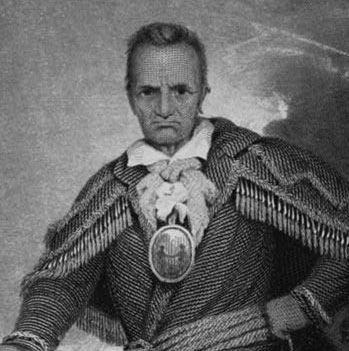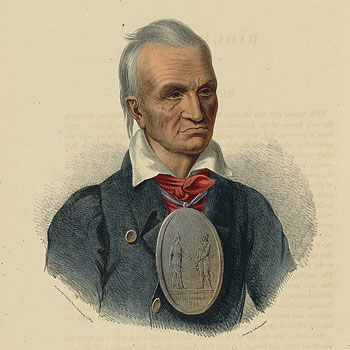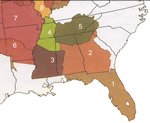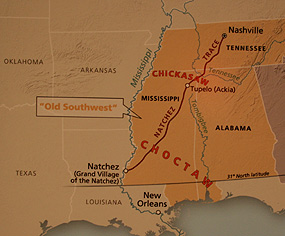|

Teacher
Resources
Jefferson
Defines Indian Policy | Monroe Alters
Direction of Indian Policies | Acculturation
Indian Removal Policy | Resistance
to Indian Removal | The Human Meaning
of Indian Removal
Lesson Plans
Jefferson
Defines Indian Policy
There
is an excellent book related to this topic: Jefferson
and the Indians: The Tragic Fate of the First Americans by
Anthony F. C. Wallace. The website contains information
and resources
that will be helpful in teaching this section.
http://www.hup.harvard.edu/features/waljef/index.html
Back
to Top
Monroe
Alters Direction of Indian Policies
Indian Peace medals were produced by the United States government
and given to Indian leaders in the course of our nation’s
negotiations with the multitude of tribes that owned the
land coveted
by the national and state governments. It is interesting
to study the different designs of these peace medals are
they evolved. Dr. Jack Campisi states:
Nearly every president from George Washington through Benjamin
Harrison had medals issued with his likeness engraved on
the front or obverse side; however, it is the reverse side
that draws our interest. Here was emblazoned in pewter, bronze,
or silver the central justification for our nation’s policy
toward Indian tribes. This policy contrasted a Euro-American
definition of civilization with a perceived Native condition
of savagery. The components of this perception are presented
on the medals in bas relief as bipolar: agriculture versus
hunting, settlement versus nomadism, war versus peace, and
ultimately assimilation versus tribalism.
Meaning in the Reverse: Indian Peace Medals by Dr. Jack
Campisi
http://www.pequotmuseum.org/Home/CrossPaths/CrossPathsWinter20034/
MeaningintheReverseIndianPeaceMedals.htm
Contrast the reverse side of the two medals
below as to the purpose and meaning behind the visual message.
|
|
George Washington Indian Peace
Medal - reverse
Etching of medallion: on recto: Red
Jacket smoking long pipe, George Washington on left
with right hand
extended, below inscription: George Washington / President
/ 1792;
on verso: presidential seal.
Prints and Photographs Division, Library of Congress
|
James Monroe Indian Peace Medal
- reverse |
These two images shows Sa-go-ye-wat-ha [Seneca chief Red Jacket]
wearing the Washington Indian Peace Medal.
 |
 |
Sa-go-ye-wat-ha [Seneca chief Red Jacket]
/ painted by R.W. Weir ; eng'd. by M.J. Danforth, Prints
and Photographs Division, Library of Congress |
Red Jacket. Seneca
war chief / on stone by Corbould from a painting
by C.B. King ; printed
by C. Hallmandel,
print, Philadelphia : Campbell & Burns,
ca. 1835. Prints and Photographs
Division, Library of Congress
|
Resources:
Back
to Top
Acculturation
 Educating the Indians : a female pupil
of the Government School at Carlisle visits her home
at Pine Ridge Agency. Frank Leslie's Illust. Newspaper,
Mar 15, 1884, cover. Prints and Photographs Division,
Library of Congress.
Educating the Indians : a female pupil
of the Government School at Carlisle visits her home
at Pine Ridge Agency. Frank Leslie's Illust. Newspaper,
Mar 15, 1884, cover. Prints and Photographs Division,
Library of Congress. |
Indian Schools
In the late 1800s, the United States supported an educational
experiment that the government hoped would change the
traditions and customs of Native Americans. Special
boarding schools were created in locations all over
the United States with the purpose of "civilizing"
American Indian youth.
Thousands of Native American children were sent far
from their homes to live in these schools and learn
the ways of white culture. Many struggled with loneliness
and fear away from their tribal homes and familiar customs.
Some lost their lives to the influenza, tuberculosis,
and measles outbreaks that spread quickly through the
schools. Others thrived despite the hardships, formed
lifelong friendships, and preserved their Indian identities.
Read more:
The Challenges and Limitations of Assimilation
The Brown Quarterly, Vol. 4, no. 3 (Fall 2001)
http://brownvboard.org/brwnqurt/04-3/04-3a.htm
|
Explore a lesson plan from the Library
of Congress about these schools:
Indian Boarding Schools: Civilizing the Native
Spirit.
This lesson plan uses photographs, letters, reports,
interviews, and other primary documents to help students
explore the forced acculturation of American Indians
through government-run boarding schools.
http://memory.loc.gov/learn/lessons/01/indian/overview.html
Websites for Indian Boarding Schools:
|
Back
to Top
Indian
Removal Policy
 Questions for Indian
Tribes Map Questions for Indian
Tribes Map
1. Even after ceding, or yielding, millions of acres of
their territory through a succession of treaties with the
British
and then the U.S. government, the Cherokees in the 1820s
still occupied parts of the homelands they had lived
in for hundreds of years. What modern states are included
within the boundaries of the Cherokee Nation? How large
is the territory compared with the modern states?
2. What other tribes lived near the Cherokees? Whites
often referred to the Cherokee, Chickasaw, Choctaw, Creek,
and
Seminole as the "Five Civilized Tribes." What do
you think whites meant by "civilized?"
Visual
Resources:
The following maps illustrate the land holdings of the Cherokee
people at specific times in history:
 |
Before the United States
expanded beyond the Mississippi River, the land that
would become Mississippi, Alabama, and Tennessee was
known as the Southwest.
This map shows the Old Natchez
Trace passing through Choctaw and Chickasaw lands. The
440-mile-long path extends from Natchez, Mississippi
to Nashville,
Tennessee, and linked the Cumberland, the Tennessee
and Mississippi rivers. The word "trace" is
an old French word which meant a line of footprints
or animal tracks.
What effect did this travel route have
on the Indian life and culture? |
National Park Service
Image
|
|
Back
to Top
Resistance
to Indian Removal
Resources for more information about women's petitions:
- Their Right to Speak: Women's Activism in the Indian
and Slave Debates By Alisse Portnoy, 2005, Harvard
University Press.
- Alisse Theodore [Portnoy], “‘A Right to Speak on the Subject’:
The U.S. Women’s Antiremoval Petition Campaign, 1829-1831,”
Rhetoric & Public Affairs, 5 (2002), 601-24.
This section from: http://expostfacto.historytools.org/womens-petitions-against-indian-removal/
In late 1829, Catherine Beecher anonymously published a circular
letter addressed to the “Benevolent Ladies” of the United
States.
Catherine Beecher, “Circular Addressed to the Benevolent
Ladies of the U. States,” Dec. 25, 1829, in Theda Purdue
and Michael D. Green, eds., The Cherokee Removal: A
Brief History with Documents, 2nd ed. (Boston: Bedford/St.
Martin’s, 2005), 111-14.
In this letter, Beecher sympathetically portrayed the “poor
Indian[s]” as a dignified people, no longer “naked and wandering
savages,” who had made much progress towards becoming Christian
and civilized. Although Beecher showed little interest in
the native cultures of the Indians of the South, her remarks
showed no sign of racism (as distinct from ethnocentrism).
Instead, she focused on the fact that the U.S. government
had promised to protect these Indians and their lands. (The
Indian nations in question included the Cherokee, Chocktaw,
Creek, Seminole, and Chickasaw, which were often collectively
referred to as the “Five Civilized Tribes” because of their
notable adaptation to white, American ways.) Beecher was writing,
she declared, because “it has become almost a certainty that
these people are to have their lands torn from them, and to
be driven into western wilds and to final annihilation, unless
the feelings of a humane and Christian nation shall be aroused
to prevent the unhallowed sacrifice.” Clearly, Beecher did
not believe the rhetoric of the Jackson administration that
removal would be voluntary and that it was necessary to protect
Indians — instead, she said, Indians’s land would be “torn”
from them, and their removal west would lead to their “annihilation.”
In short, Beecher thought that she saw through the pro-removal
rhetoric to the real reason that Indians were to move west
— their “fertile and valuable” lands were “demanded by the
whites as their own possessions.”
This letter helped inspire a small but significant petition
campaign on the part of American women. Alisse Portnoy has
carefully studied this petition campaign. While her article
helps document the political resistance to the Indian removal
policy, it also shows how women in the early republic period
began tentatively to assert a “right to speak” regarding political
issues. Portnoy shows that how these women spoke is just as
important as the fact that they did so.
Here are several questions to consider when reading this
essay:
- What main arguments does Portnoy make?
- What evidence does she bring forward? Where did she get
this evidence?
- Where did the petitions come from? What might be the significance
of their regional source?
- Why are these petitions historically significant?
- Why weren’t the petitions effective in changing Indian
policy?
Back
to Top
The
Human Meaning of Indian Removal
What went wrong on the Trail of Tears? Ask students
to compare Scott's letter and general order, statements about
what should have happened, with Burnett's narrative of what
he saw. Since soldiers did not, routinely ignore
general orders, the vast discrepancy between these primary
sources calls
Scott's sincerity into serious question. The fact that the
army did not investigate what happened also suggests that
the general order was never supposed to be taken literally.
 Questions
for Trail of Tears Map Questions
for Trail of Tears Map
1. How many different routes are shown? Why do you think
there might have been so many?
2. Find the water route. What rivers does it follow? What
advantages to you think it might have over an overland route?
What difficulties might it present?
3. Locate the land route. How does it compare with the other
main routes? What major rivers did it cross? What advantages
and what disadvantages might the Land Route have?
4. The largest group of Cherokees followed the land route.
They left Tennessee in the late fall of 1838 and arrived
in Indian Territory in March. What problems do you think
they might have encountered on the journey?
Resources:
Back
to Top
Lesson
Plans
Primary
grades:
- Traditions
and Languages of Three Native Cultures: Tlingit, Lakota,
& Cherokee
This lesson compares the cultures and languages of the
Tlingit, Lakota, and Cherokee American Indian tribes, and
helps students learn the importance of preserving a group's
traditions.
http://edsitement.neh.gov/view_lesson_plan.asp?id=378
- Native American Cultures Across the U.S.
This lesson discusses the differences between common
representations of Native Americans within the U.S. and
a more differentiated view of historical and contemporary
cultures of five American Indian tribes living in different
geographical areas. Students will learn about customs and
traditions such as housing, agriculture, and ceremonial
dress for the Tlingit, Dinè, Lakota, Muscogee, and
Iroquois peoples.
http://edsitement.neh.gov/view_lesson_plan.asp?id=347
Middle grades:
- Not 'Indians,' Many Tribes: Native American Diversity
Students study the interaction between environment and
culture as they learn about three vastly different Native
groups in a game-like activity that uses vintage photographs,
traditional stories, photos of artifacts, and recipes.
http://edsitement.neh.gov/view_lesson_plan.asp?id=324
- Anishinabe - Ojibwe - Chippewa: Culture of an Indian Nation
This lesson focuses on one American Indian Nation, the
Anishinabe, also known as the Ojibwe, Ojibway, or Chippewa
Indians. Students will learn how to conduct a research project
on different historical, geographical, and cultural aspects
of this Native American group.
http://edsitement.neh.gov/view_lesson_plan.asp?id=369
- Native American policy
The lesson supports students' examination of the different
views and policies about native americans from 1787 through
1830.
http://www.historynow.org/09_2006/lp3.html
Secondary grades:
|
